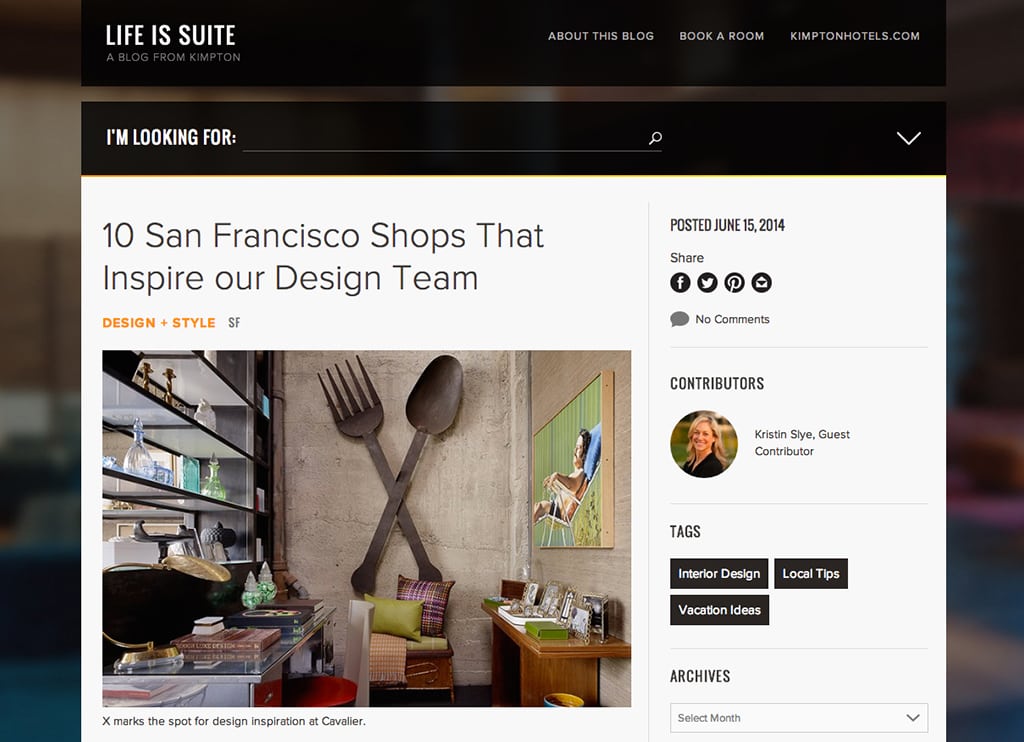Skift Take
Boutique properties have the freedom to experiment more than their larger, corporate peers, and they need to just to stand out from the noise.
Earlier this week we launched our latest report in our Skift Trends series, Content Marketing Strategies for Hospitality Brands.
Below is an extract. Get the full report here to get ahead of this trend.
Over the last decade, many of the boutique/design and smaller luxury hotel brands have been at the forefront of content marketing trends, mainly because they’ve always positioned themselves as lifestyle experiences.
Hotel groups like Thompson, Kimpton, Joie de Vivre, and SBE rely on interesting online story narratives to help sell their on-property experience much more so than larger corporate brands during the consumer research phase. However, whatever these design-driven brands do now is often picked up by the big brands eventually.
Kimpton Hotels launched an all-new version of its website in the summer of 2014 to interact with viewers on a deeper and more personal level, while engaging them longer on a year-round basis.
“Our goal was to ensure that our digital experience really matches and aligns with the hotel experience,” says Kathleen Reidenbach, SVP of marketing at Kimpton Hotels. “Anyone can put a great website together that has glossy pictures and cool content, but does the website and blog make you smile? We want to make sure that the love affair that occurs between guests and Kimpton is happening when you plan your next trip.”
The strategy behind the website redesign integrated Kimpton’s primary brand values: different, original, down-to-earth, healthy, simple and carefree. So the new website is more visual-first in its delivery, and the content is more localized and in depth with a 50-50 split between hotel and destination editorial. The non-hotel content is further split between travel information, such as the top 10 places to go for bike rides near a hotel, and lifestyle-oriented posts with actionable takeaways, such as recipes and fashion trends.
For the Life is Suite blog, it was removed from its independent URL and embedded into the brand.com site. Blog content is assigned to in-house and freelance writers as determined by guest data.
“We’re pulling from studies we’ve done on Kimpton guests and their psychographic behavior and buying behavior, and how they’re living their lives,” Reidenbach says. “For Kimpton guests, they over-index in things like health and wellness, and pets, and wine and travel, and it’s also really important to them that they have a local experience.”
Previously, travelers researching the Kimpton site would explore the different hotel pages throughout the portal for a cursory overview. Then, if they were interested in more in-depth information, they would go to the independent, standalone hotel websites. With the new site, Kimpton wanted to provide the full shopping experience within its own platform. Strategies to accomplish that include more visible third-party validation and reviews on the hotel pages, a full-width slideshow with much more updated photography than before, Google Maps, a series of hotel highlights, and relevant blog content.
“There’s just this overwhelming amount of places to research travel online, so we want to help connect the dots and make it easier for people when they’re looking for information about Kimpton, to find it, recognize it and feel comfortable with it,” says Demoney. “It’s confusing if you go to a bunch of different sites and it doesn’t make sense as a whole.”
Have a confidential tip for Skift? Get in touch
Tags: content marketing
